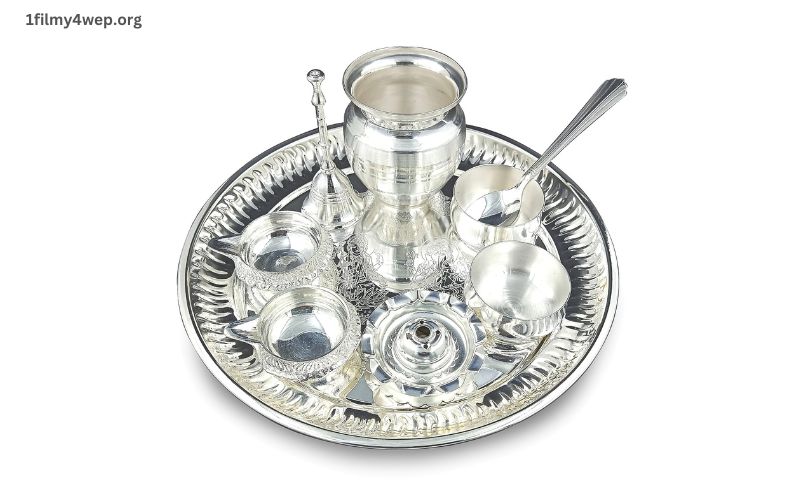Pure silver pooja items hold a revered status in Indian culture, symbolizing purity, prosperity, and auspiciousness. Crafted by skilled artisans using age-old techniques, these artifacts showcase intricate designs and meticulous attention to detail. From idols of Hindu deities to puja thalis and lamps, each item serves a specific purpose in religious rituals, enriching the worship experience. The pricing of pure silver pooja items varies based on factors such as weight, craftsmanship, and market demand. While they may command higher prices compared to other materials, their durability and timeless appeal make them a worthwhile investment for devout individuals and families. Beyond their monetary value, these artifacts carry a profound spiritual significance, connecting worshippers to their cultural heritage and invoking divine blessings in their homes and temples.
Introduction
In the rich tapestry of Indian culture, rituals and traditions hold a special place. Among these, the practice of pooja (worship) is not just a religious obligation but also a revered custom passed down through generations. Essential to this practice are the pooja items, ranging from lamps to utensils, each imbued with symbolism and significance. Among the materials used for crafting these items, silver stands out for its purity, elegance, and timeless appeal. In this article, we explore the world of pure silver pooja items, delving into their significance, craftsmanship, and the pricing landscape.
Significance of Silver in Pooja Items
Silver has held a revered status in Indian culture since ancient times. It is believed to possess purifying properties, making it an ideal material for pooja items. The shimmering metal symbolizes purity, prosperity, and auspiciousness, attributes that align perfectly with the sanctity of religious rituals. In Hinduism, silver is associated with the Moon, a celestial body revered for its calming influence and association with purity.
Craftsmanship and Design
The craftsmanship involved in creating pure silver pooja items is a testament to the rich artistic heritage of India. Skilled artisans employ age-old techniques passed down through generations to shape silver into exquisite forms. From intricately carved idols of deities to finely engraved puja thalis (plates), each piece reflects meticulous attention to detail and a deep understanding of religious symbolism.
The design of silver pooja items is often inspired by traditional motifs and scriptures. Floral patterns, geometric designs, and depictions of gods and goddesses adorn these artifacts, adding to their visual appeal and spiritual significance. Additionally, the versatility of silver allows artisans to experiment with various textures and finishes, ranging from polished surfaces to antique patinas, further enhancing the beauty of the items.
Range of Pure Silver Pooja Items
The range of pure silver pooja items available in the market is extensive, catering to diverse preferences and rituals. Some of the most common items include:
- Silver Idols: Statues of Hindu deities crafted in silver serve as focal points of worship in home and temple altars. These idols range in size from small ones for personal use to larger ones for elaborate rituals.
- Puja Thalis: Silver puja thalis or plates are used to hold offerings such as flowers, incense, and sacred water during worship ceremonies. They are often adorned with intricate patterns and may feature compartments for different items.
- Lamps and Diyas: Silver lamps, or deepams, are an essential part of Hindu rituals, symbolizing the dispelling of darkness and ignorance. Diyas, or oil lamps, crafted in silver, add a touch of elegance to festive decorations.
- Kalash and Panchapatra: Silver kalash, or water vessels, are used in rituals symbolizing purity and abundance. Panchapatra and udharini, a set of vessels used for offering water, are also crafted in silver for their symbolic significance.
- Bell and Conch: Silver bells and conch shells are integral to Hindu rituals, believed to invoke divine presence and ward off negative energies. They are often embellished with intricate designs and serve both functional and decorative purposes.
Pricing Landscape
The price of pure silver pooja items varies depending on factors such as weight, craftsmanship, and design intricacy. As silver is a precious metal, its market price fluctuates, directly influencing the cost of silver artifacts. Additionally, the reputation of the artisan or brand, along with the demand for specific designs, can also impact pricing.
On average, smaller items such as silver diyas and bells may range from $20 to $100, while larger pieces like silver idols or puja thalis can cost anywhere from $100 to several thousand dollars, particularly for intricately crafted or custom-made pieces. Antique silver pooja items, boasting historical significance or unique designs, may command even higher prices among collectors and enthusiasts.
While the initial cost of pure silver pooja items may seem higher compared to their counterparts crafted from other materials, their durability and timeless appeal make them a worthwhile investment for devout individuals and families. Moreover, the spiritual significance attached to silver adds an intangible value that transcends monetary considerations.
Conclusion
Pure silver pooja items embody the essence of Indian spirituality, blending aesthetic beauty with symbolic significance. Crafted with precision and imbued with tradition, these artifacts serve as conduits for devotion and reverence in Hindu rituals. While their prices may vary, the intrinsic value they hold in religious and cultural contexts is immeasurable. As custodians of tradition, silver pooja items continue to adorn homes and temples, preserving ancient customs and enriching spiritual experiences for generations to come.

